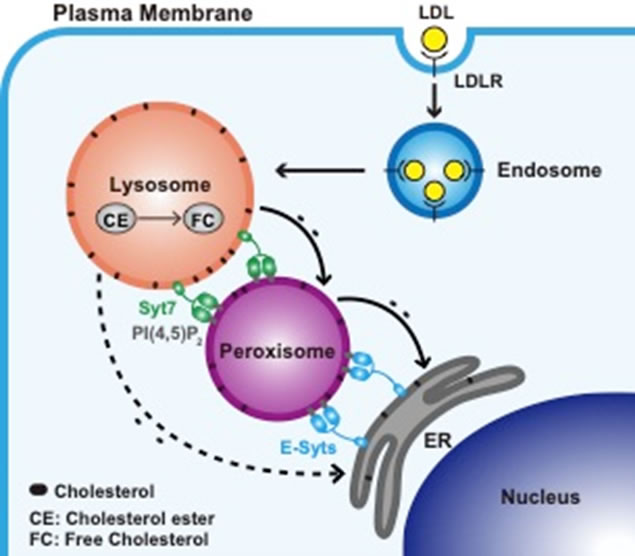On May 22nd, 2019, Professor Song's lab from the College of Life Sciences at the Wuhan University published a research article entitled “Cholesterol transport through the peroxisome-ER membrane contacts tethered by PI(4,5)P2 and extended synaptotagmins” on the SCIENCE CHINA Life Sciences journal. The work reports that membrane contacts between peroxisome and endoplasmic reticulum, which are formed by peroxisomal PI(4,5)P2 and endoplasmic reticulum resident protein Extended Synaptotagmins (E-Syts), serve as an important route for LDL-derived cholesterol to traffic through after leaving lysosomes. The graduate student Jian Xiao and the associate professor Jie Luo are the co-first authors of this paper.
Cholesterol is a key lipid molecule regulating membrane biophysical properties. It is distributed in varying concentrations on different organelle membranes. How hydrophobic cholesterol molecules are transported among organelles is a long-lasting question to be resolved. In regard to the post-lysosomal cholesterol transport, the dogma is that LDL-derived cholesterol is delivered from lysosome to the endoplasmic reticulum via the plasma membrane. However, most of the evidence supporting this view came from studies performed under cholesterol deprivation conditions, where cholesterol level on the plasma membrane was acutely and artificially depleted. Whether and how cholesterol, under physiological conditions, is transported from lysosomes to ER bypassing the plasma membrane are unclear.
In their earlier work (Chu BB et al., 2015, Cell), Song’s lab identified that lysosome-peroxisome membrane contacts mediated cholesterol egress out of lysosomes. In the present study, the authors found peroxisome and endoplasmic reticulum were closely apposed to each other. The interorganellar contact sites were successfully reconstituted in vitro using highly purified peroxisomes and endoplasmic reticulum membranes. Knockdown of peroxisomal PI(4,5)P2 or E-Syts decreased membrane contacts between peroxisome and endoplasmic reticulum and caused massive cholesterol accumulation in lysosomes. By using the in vitro reconstitution system, the authors further demonstrated transport of 3H-labeled cholesterol from peroxisome or artificial liposomes containing PI(4,5)P2 to endoplasmic reticulum membranes.
Based on these results the authors conclude that cholesterol is transported from peroxisome and endoplasmic reticulum via membrane contact mediated by PI(4,5)P2 and E-Syts. Together with the previous findings on lysosome-peroxisome membrane contacts, Prefessor Song’s lab delineates a critical intracellular cholesterol transport pathway of LDL-derived cholesterol along the lysosome-peroxisome-ER axis.


